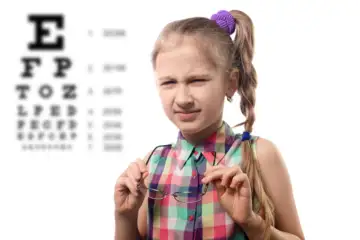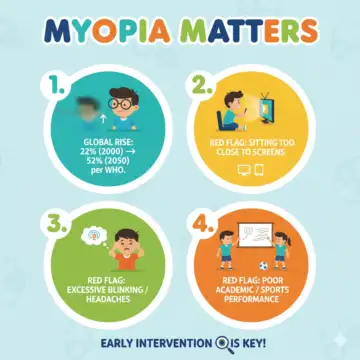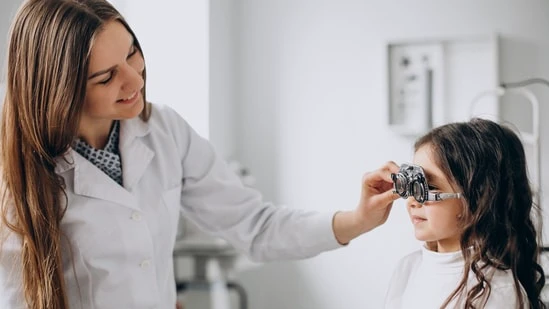Myopia, or near-sightedness, is one of the most prevalent vision disorders among children. Per the National Institutes of Health, its prevalence rate is increasing worldwide, and as per the World Health Organisation (WHO), it is projected to go up from 22 percent in 2000 to 52 percent by 2050.
To understand how myopia affects children and recognise the red flags that indicate your child might be struggling with it, HT Lifestyle spoke with Dr Divya B, MBBS, MS, a consultant paediatric ophthalmologist. According to Dr Divya, when one has myopia, distant objects appear blurry while close objects can be seen clearly.
All you need to know about myopia
She emphasised, “Reportedly, 32 percent of children may be affected by 2030, rising to 40 percent by 2040, and alarmingly, close to 48 percent by 2050. These numbers represent a pressing public health challenge that demands urgent intervention and demand for effective measures to be put into place.”
 According to the ophthalmologist, myopia often progresses rapidly during childhood and adolescence. Moreover, early intervention can slow this progression and reduce the risk of high myopia, which is associated with:
According to the ophthalmologist, myopia often progresses rapidly during childhood and adolescence. Moreover, early intervention can slow this progression and reduce the risk of high myopia, which is associated with:
- Increased risk of retinal detachment
- Glaucoma
- Cataracts in later life
“Regular eye exams, especially for children with a family history of myopia, are essential for early detection and effective management. Parents are encouraged to watch for red flags, which may indicate a child is developing myopia,” she added.
Here are the 5 red flags Dr Divya highlighted:
1. Frequent squinting
“A child who frequently squints or closes one eye to see distant objects more clearly may be attempting to sharpen blurry vision. This instinctive action serves to temporarily improve focus and may become noticeable when the child watches TV, reads from the board at school, or looks at distant objects,” the ophthalmologist noted.
2. Sitting too close to screens
Children with myopia, Dr Divya noted, often sit unusually close to the television or hold books and devices near their faces. “This behaviour is a way to compensate for blurred distance vision, and they may also prefer to sit at the front of the classroom or move closer to screens,” she added.
 3. Complaints of headaches
3. Complaints of headaches
“Frequent headaches, especially after activities requiring distance vision, are a common sign of uncorrected myopia,” Dr Divya cautioned. “Eye strain and fatigue can occur when a child repeatedly struggles to see clearly, sometimes resulting in discomfort following tasks like watching a movie or attending school.”
4. Excessive blinking or eye rubbing
Dr Divya noted that another sign which is often observed in children with myopia is excessive blinking or eye rubbing.
“This particularly occurs when they are focusing on distant objects. This response to blurred vision or strain is common during homework or screen time and should not be overlooked,” she added.
5. Poor academic or sports performance
Lastly, a drop in academic performance or difficulty with sports and activities that require good distance vision may be linked to undiagnosed myopia. She explained, “Children may struggle to read the board at school or to participate in activities that involve tracking objects at a distance, such as catching a ball.”
Prevention is better than a cure
Preventing the progression of myopia involves lifestyle and behavioural strategies at home and school, the ophthalmologist shared. She suggested encouraging children to spend at least two hours outdoors daily, as exposure to natural sunlight produces dopamine in the retina, which helps inhibit the abnormal elongation of the eye that causes myopia.
“Limiting continuous near-sighted work, such as reading or screen time, by implementing the ’20-20-20′ rule, taking a 20-second break to look at something 20 feet away every 20 minutes, can reduce eye strain,” Dr Divya advised.
Lastly, she advised parents, “Maintaining proper reading distances and good lighting conditions is also important to prevent worsening myopia. In some cases, eye care professionals may recommend specialised treatments such as atropine eye drops or specially designed contact lenses and glasses that slow eye growth by altering how light focuses on the retina.”
If any of the aforementioned red flags are present, Dr Divya noted that parents should consult an eye care professional promptly. Timely diagnosis and management can help maintain clear vision.
